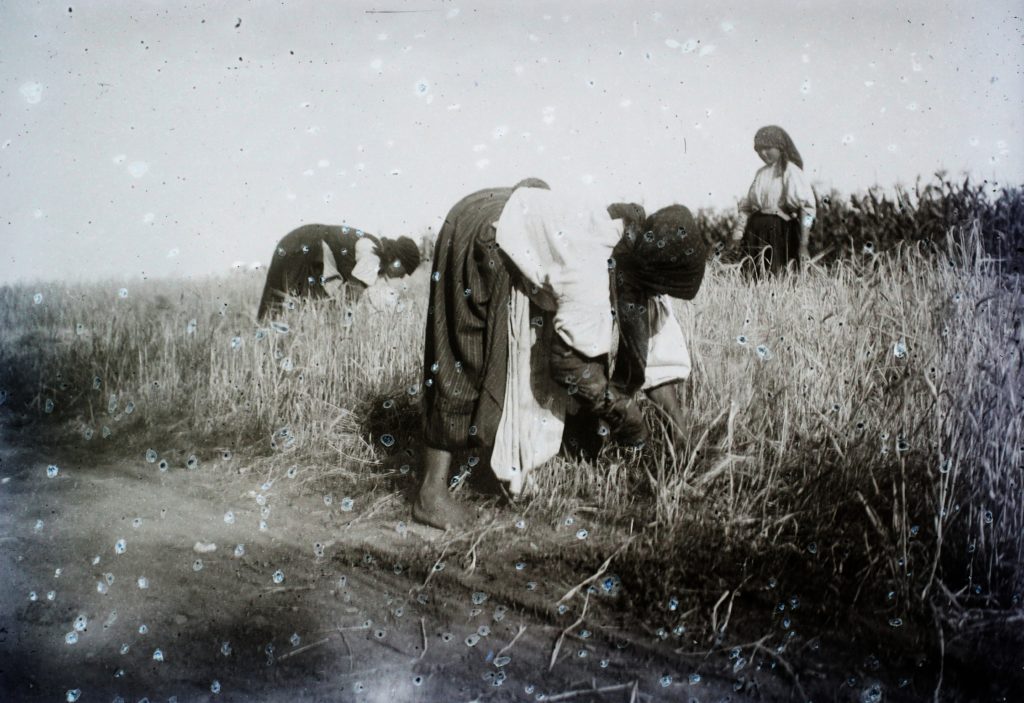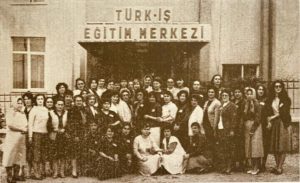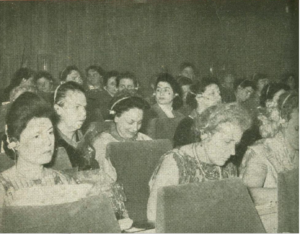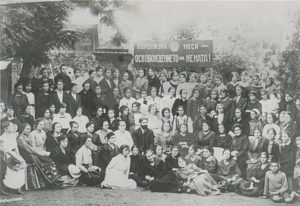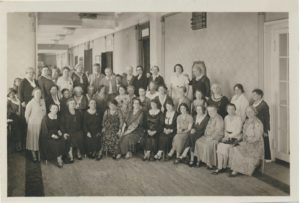by Eszter Varsa
In a letter written on 3 June 1908 addressed to the leader of the Hungarian Feminist Association, Rosika Schwimmer, Mrs. Gábor Magyar[1] extended sisterly greetings to the members of the association. She mentioned the founding of their own women’s organization that happened earlier that year and was made up of poor agricultural women workers in the city of Balmazújváros, calling for sisterhood between the women of these two groups with the following words: “Greetings in the name of all working women of Balmazújváros for the rights of all women in the world. […] Let us be arm in arm and embosom each other…If one carries true sisterly (testvéri)[2] love, the true love of Christ, as had been taught by Christ, to love one another, then us sisters, we cannot hate each other if one of us has a somewhat better lot than the other. […] Thus our dear sisters, we have founded the Free Women’s Association of Balmazújváros. Do not thus be estranged from us, because us poor working women we really love all our sisters in the world as Jesus has loved us. We thus call upon all the sisters to organize with us in one camp and let this be our motto. Let us all stand under the banner of freedom and sisterly love upon which it should be written: World Freedom.”[3]
How to make sense of the mixing of Christian notions, such as the love of Christ, with the idea of a fight for world freedom, women’s rights and sisterhood?
In this blog post, I show that these expressions speak of the influence of anarchism, including peasant religious anarchism and a specific variety of anarchism developed in Hungary, called ideal anarchism, on peasant women in turn-of-the 19th to the 20th century Hungary.
This letter is one of the first in a series of letters written by the group of politically active peasant women of Balmazújváros, a city in North-Eastern Hungary to the middle-class-based Feminist Association in the Hungarian capital, Budapest.[4] What is known about the Free Women’s Association of Balmazújváros is that it was formed in 1908 around the same time when local agrarian socialist men founded the left-wing National Agricultural Party. The men of Balmazújváros were by then already long-time participants of the struggle of the small landholder and landless peasants for better working and living conditions that had enfolded in Hungary in the 1890s.
The members of the Free Women’s Association, just like their men comrades, were involved in trying to improve the living and working conditions of agricultural workers in a variety of ways. They were, for example, involved in the activities leading to the founding of the new peasant party that organized around the issue of universal suffrage. Their definition of general, secret and equal suffrage extended to the until then by left-wing parties marginalized case of women’s suffrage. The women of Balmazújváros were engaged in establishing and fostering contacts with the Feminist Association, whose political activities have concentrated on gaining electoral rights for women.[5]
The aforementioned letter by Mrs. Magyar was the second following up on an earlier one written by another member of the group, Sára Rokon Tóth, on 1 June 1908. The women were greatly affected by the visit of Rosika Schwimmer at one of their first gatherings only some days beforehand, on Ascension Day, 28 May. The series of letters, mostly authored by Sára Rokon Tóth, discussed the local situation of poor peasants and events related to women’s political engagement. These include specific activities they carried out to win other women for the cause of women’s suffrage in their own and other localities.
Mrs. Magyar, who had identified herself in her letter as the inspector of the Free Women’s Association expressed the group’s wish to establish sisterly relations with the feminists. Her letter stands out in the series because it radically differs in its use of expressions from those written by Sára Rokon Tóth.
Anarchism was an influential movement at the time in different European regions and across the Atlantic. Examples include rural Southern Italy and Spain, the Latin American contexts of Mexico and Argentina as well as the US, where Italian and Spanish immigrants exported anarchist thought. While in these contexts women’s particular contribution to anarchism has already been richly discussed, there is still a lack of a systematic gendered analysis of anarchism and women’s involvement in anarchist activism concerning Eastern Europe.[6]
Anarchism was attractive to women, particularly to working-class women in both urban and rural contexts, because it offered them means to express their frustration with and act upon their desire to eliminate the conditions of discrimination that affected them both as women and working-class members of society. A struggle against authority, power and oppression that characterized anarchist thought “opened up a space within which women could be seen simultaneously as the victims of society and as the victims of male authority,” and give voice more than through mainstream socialism to the specificity of women’s oppression.[7] Under the influence of Greek, Spanish, and Italian exiles, Mexican anarchists, for example, adopted an ideology based upon the emancipation of the individual, creation of a libertarian union between man and woman, self-management of artisan shops, and the elimination of the patriarchal family, Church, State, and private property.[8] An emphasis in anarchism on “direct action and community-building from below opened doors in some contexts for forms and dynamics of women’s involvement less common in the social-democratic wing.”[9]
Thus, in the 1890s Buenos Aires anarchist working-class women of Spanish and Italian origin ran their own paper addressed to women in which they called for an end to women’s sexual exploitation by men.[10] At the same time in South Italian towns, poor peasant women led a wave of uprisings that soon spread across the whole country and grew into a revolutionary struggle for a more egalitarian society. Italian socialist-anarchist peasant women’s unique contribution to this movement was their combination of spirituality with social egalitarianism. It stemmed from their own world infused by a great deal of mysticism, which Jennifer Guglielmo identifies as a space of power women developed in response to their conditions of poverty and (gendered) subordination.[11]
Guglielmo describes how women, who created their own unions, celebrated this “as they would a religious festival,” and wove together in their speeches “political and spiritual ideologies.”[12] An example from one of these speeches resembles Mrs. Magyar’s letter in its particular blend of class conscious and spiritual language: “We want everybody to work as we work. There should no longer be either rich or poor. All should have bread for themselves and their children. We should all be equal…Jesus was a true socialist and he wanted precisely what we ask for, but the priests don’t discuss this.”[13]
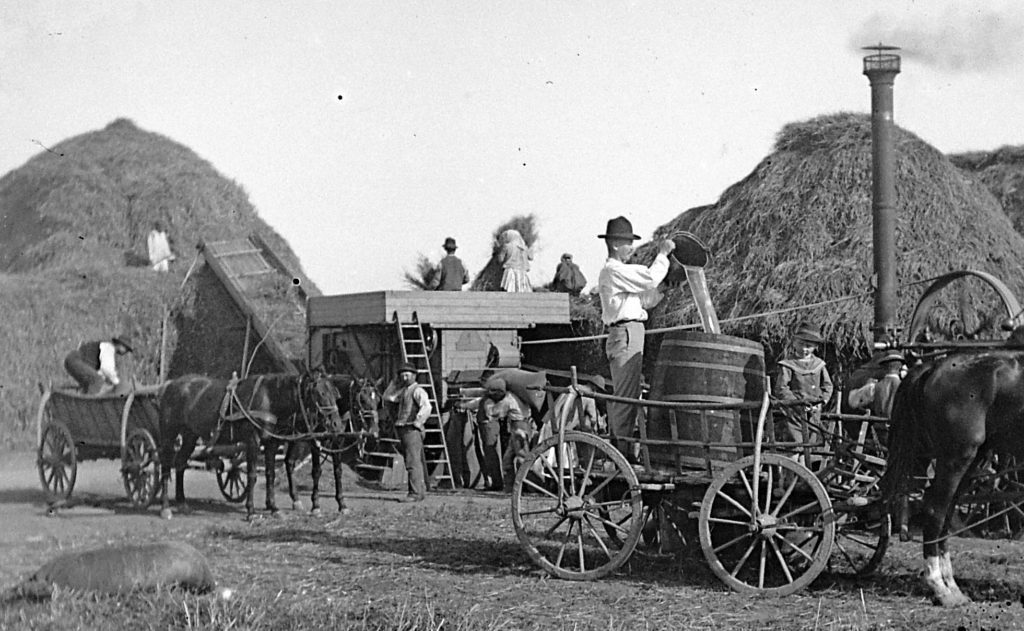
While anarchism had a limited presence in Hungary, it affected the agrarian socialist movement that first unfolded on the Great Plain and the South-Eastern border regions of the Austro-Hungarian Monarchy in the 1890s. It soon spread further to the Upper Tisza region, including to Szabolcs County, where Balmazújváros became one of its particular strongholds.[14] András Bozóki and Miklós Sükösd in their history of anarchism in Hungary have drawn attention to “the Reformation tradition, the practice of popular biblical exegesis and the rapid spread of communist sects and later workers’ circles” as a particular characteristic of the great Plain region that has made it “fertile ground for socialist and anarchist ideas.”[15] A millenarian expectation towards radical changes manifested in a mixture of religious elements and socialist ideas. At the meetings of socialist peasant circles, for example, it was not uncommon to have the picture of Christ together with that of Marx or Lasalle.[16]
At the peak of the agrarian socialist movement in the mid-1890s, a rapidly growing group of poor peasants under the leadership of István Várkonyi split from the Social Democratic Party due to its lack of attention to the cause of agricultural workers. They started their own weekly paper called Földmívelő (Agricultural Worker) and following two congresses in 1897 they founded the Independent Socialist Party. The Várkonyi movement was affected by anarchist ideas as advanced by Jenő Henrik (Eugen Heinrich) Schmitt, a Hungarian- and German-language philosopher. Földmívelő published Schmitt’s articles, who was in intensive exchange with Leo Tolstoy and whose anarchism, he called ideal anarchism, was close to Tolstoyanism.[17]
Schmitt’s convictions about a social order based on “brotherhood, and a loving community governed by the laws of freedom” were enthusiastically supported by independent socialists.[18] Schmitt’s particularity was that he put great effort into agitating among poor peasants, infusing independent socialism with anarchist ideas, such as a “social order free of oppression,” based on “decision-making by consensus after free discussion, and with no central leadership and no party discipline.”[19] As in Tolstoyanism, in Schmitt’s ideal anarchism, Christ’s teachings of the Law of Love occupied a central place and were key to the opposition of the state as a form of government based on violence. Freedom and the free person were important notions here: One “could not be free until the state was destroyed, since crime and violence both originated in the institution of government. […] Government is violence; Christianity is meekness, non-resistance, love. […] A person, who wishes to be a Christian must not serve the government.”[20]
Articles in Földmívelő and one of Schmitt’s own papers entitled Állam nélkül (Without a State) reported about the centers of anarchism and the founding of Tolstoyan peasant communes in a number of localities where independent socialism was strong. One of these was Balmazújváros, where around 1900 to 1902 twelve families led by a smallholder, who corresponded with both Schmitt and Tolstoy, founded a self-governing commune. Schmitt’s teachings about these communes emphasized non-violence and Christian love “that would unite all those who sought to follow Christ’s pure teachings.”[21]
It is not known whether Mrs. Magyar or any of the other members of the Free Women’s Association of Balmazújváros had belonged to the former commune. But the agrarian socialists of Balmazújváros were ardent readers of both Földmívelő and Állam nélkül. The women’s choice of the word “free” in the name of their association could certainly be alluding to and could have well been motivated by ideal anarchist thought. It would also explain why Mrs. Magyar chose freedom as the motto under which she spoke out against hatred and for sisterhood in the name of true Christian love. Finally, the word “testvéri” might actually be related to the custom of the Tolstoyan brethren to call each other brothers and sisters. Certainly, anarchism has not only affected the men among the agrarian socialists in Hungary. Mrs. Magyar’s letter provides a first insight into this yet uncovered history.
[1] Rosika Schwimmer in her account of her visit at the gathering of the women of Balmazújváros has recorded Mrs. Gábor Magyar’s name including her maiden name: Mária Sós. A nő és a társadalom [Woman and Society] 2, no. 9 (1908): 144.
[2] The word in Hungarian is gender-neutral.
[3] Mrs. Gábor Magyar to Rosika Schwimmer, Balmazújváros, 3 June 1908, Magyar Nemzeti Levéltár Országos Levéltára [National Archives of Hungary – National Archives], P999 Feministák Egyesülete [Feminist Association], Box 3 Folder 5) (03 June 1908). Available at Women and Social Movements in Modern Empires since 1820, https://search.alexanderstreet.com/view/work/bibliographic_entity%7Cbibliographic_details%7C3819586 The Hungarian original was written without punctuation. Translation by the author.
[4] The exchange started in 1908 and went on into the interwar period. The letters written by the women of Balmazújváros between 1908 and the 1910s can be found at Women and Social Movements in Modern Empires since 1820, https://alexanderstreet.com/products/women-and-social-movements-modern-empires-1820. For an analysis of the contact between the two organizations, see Zimmermann, Susan, “Female Agrarian Workers in Early Twentieth-Century Hungary: The Making of Class- and Gender-Based Solidarities,” Aspasia 12, no. 1 (2018): 121-133, https://doi.org/10.3167/asp.2018.120107 and Acsády, Judit and Zsolt Mészáros, “A Balmazújvárosi Szabad Nőszervezet és a Feministák Egyesülete közötti kapcsolat (1908–1929): A női szolidaritás megnyilvánulásai a hazai feminista mozgalomban” [The Relationship between the Free Women’s Association of Balmazújváros and the Feminist Association (1908-1929): Manifestations of Female Solidarity in the Hungarian Feminist Movement], TNTeF 8, no. 2. (2018): 80-96; Czeferner, Dóra, “Bourgeois-liberal, feminist associations and their press activity in the Austro-Hungarian Monarchy (1907-1918): Associations, periodicals, content analysis” (PhD diss., University of Pécs, 2020). See also Veres, Péter, Falusi krónika [Village chronicle] (Budapest: Magvető, 1956).
[5] Zimmermann, “Female Agrarian Workers.”
[6] Molineux, Maxine, “No God, No Boss, No Husband: Anarchist Feminism in Nineteenth-Century Argentina,” Latin American Perspectives 13, no. 1 (1986): 119-145, doi:10.1177/0094582X8601300106; Acklesberg, Martha A., Free Women of Spain: Anarchism and the Struggle for the Emancipation of Women (Bloomington: Indiana Press, 1991); Wood, Andrew Grant, Revolution in the Street: Women, Workers, and Urban Protest in Veracruz, 1870-1927 (Wilmington, DE: SR Books, 2001). Wood, Andrew Grant, “Postrevolutionary pioneer: Anarchist María Luisa Marín and the Veracruz renters’ movement,” posted on 2 January 2021, https://libcom.org/history/postrevolutionary-pioneer-anarchist-mar%C3%AD-luisa-mar%C3%ADn-veracruz-renters%E2%80%99-movement-1; Fowler-Salamini, Heather, Agrarian Radicalism in Veracruz, 1920-1938 (Lincoln: University of Nebraska Press, 1978); Fowler-Salamini, Heather, “Women Coffee Sorters Confront the Mill Owners and the Veracruz Revolutionary State, 1915-1918,” Journal of Women’s History 14, no. 1 (2002): 34-63; Guglielmo, Jennifer, Living the Revolution: Italian Women’s Resistance and Radicalism in New York City, 1880-1945 (Chapel Hill: The University of North Carolina Press, 2010).
[7] Molineux, “No God, No Boss, No Husband,” 129.
[8] Fowler-Salamini, “Women Coffee Sorters,” 42.
[9] Zimmermann, Susan, “Socialism, Gender, and the Emancipation of Women,” in Marcel van der Linden (ed.). The Cambridge History of Socialism, vol. 2. Cambridge University Press, (forthcoming).
[10] Molineux, “No God, No Boss, No Husband,” 132-133.
[11] Guglielmo, Living the Revolution, 9, 26-40.
[12] Ibid., 10.
[13] Ibid., 10-11.
[14] Among others: Bozóki, András and Miklós Sükösd, Anarchism in Hungary: Theory, History, Legacies (Boulder Colorado: Social Science Monographs and Wayne, New Jersey: Center for Hungarian Studies and Publications, Inc., 2005); Erényi, Tibor, “Az anarcho-szindikalizmusról” [On anarcho-syndicalism], Párttörténeti Közlemények 14, no. 3 (1968): 167–188; Farkas, József, “Ne legyen többé se úr, se szolga!” Az agrárszocialisták eszmevilága [“May there be no lords and no servants any more!” The ideological landscape of the agrarian socialists] (Budapest: Kossuth, 1989); Jemnitz, János, “Az anarcho-szindikalizmus Magyarországon 1914 előtt” [Anarcho-syndicalism in Hungary before 1914], Párttörténeti Közlemények 7, no. 1 (1961): 129–176; Mikonya, György: “A magyar anarchisták iskolaügyi és életreform törekvései” [The educational and life reform goals of the Hungarian anarchists] Iskolakultúra 15, no. 2 (2005): 52-62.
[15] Bozóki and Sükösd, Anarchism in Hungary, 71.
[16] Ibid., 72.
[17] Brock, Peter, “Tolstoyism and the Hungarian Peasant,” SEER 58, no. 3. (1980): 345-369.
[18] Ibid., 353.
[19] Ibid. 353, 357.
[20] Ibid., 358.
[21] Ibid., 361.
Illustrations:
- Harvesting women, n.p., 1912, Fortepan / Hungarian Geographical Museum/ Zoltán J. Kerekes.
- Thrashing with the Hofherr-Schrantz-Clayton-Shuttleworth thrasing maschine, n.p., 1912, Fortepan / Fortepan.

